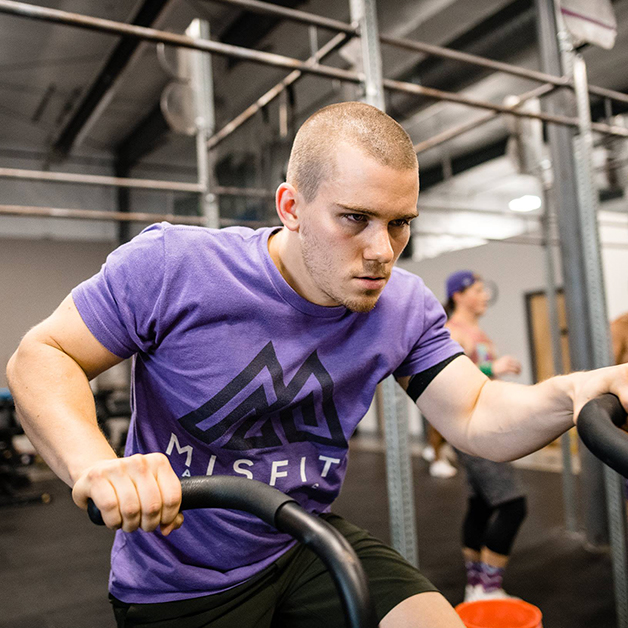We’ve been looking for ways to address the importance of mental health in our community for some time. Much like other ultra-personal topics, there is a level of vulnerability needed on the part of the writer and reader to establish meaningful conversation in a safe environment. This article marks a moment when we begin education and dialogue designed to uncover hidden elements of an essential topic to progress as athletes and humans.
Don’t fret, Misfits. This is not the first article in a series where we eventually pitch you on a pyramid scheme. Aside from mindfulness being a buzzword in and of itself, we’re calling upon thousands of years of human tradition when referencing a practice aimed at fully experiencing the present moment. Knowing there was use for such a practice thousands of years ago is both a nod to its importance in general, as well as the heightened need in our rapidly evolving society. As athletes, you are already adept at learning new skills and often can accept the natural order of things better than the general population. Already having a leg up is important in this conversation because, as I hope you find in your new journey, being present-minded is very much a skill, and skills are developed, not found.
Why Athletes?
Aside from the obvious benefits of improving your mental health, there are key connections between success and presence of mind. The idea of ‘right place, right time’ is important but incomplete. The real saying, albeit a touch less sexy, should be ‘right place, right time, aware, and ready.’ One of the superpowers of highly successful people is their ability to address the task at hand as if nothing else in the world exists. Doing so simultaneously checks off the ‘ready’ box while facilitating the further development of presence of mind. Without all of the worries of yesterday and tomorrow, we can see opportunities as they arise in real-time. Preparedness and presence of mind are the untold prerequisites for your own’ right place, right time’ moments.
While letting your past define your present and future is one of the more apparent downfalls of lacking presence of mind, another common idea that often creates what feels like a positive fantasy is what I like to call ‘future chasing.’ Consistently emphasizing something that will occur at a later date as your impetus for change or growth is future chasing. A narrative designed to give you hope because when X happens, things will change, and then Y and Z will be just around the corner. The gift of the present is that it is the only real effect you can have on your future. The seeds for your future must be planted and watered now to be grown when you’re hoping they will just appear. This is where presence of mind allows you to take control of your own destiny back.
Why Mindfulness?
If you’re like me, you need a little science to back up a suggested practice, especially when the topic could be in the flavor-of-the-month club. While the measurement of being present-minded can be tricky, the other side of the coin is not. Stress is the manifestation of our fight or flight response built into our autonomic nervous system’s sympathetic branch. As an athlete, you’ve undoubtedly become very aware of the effects of both mental and physical stress. Let’s take a look at what we’re up against when we fail to prioritize our mental health:
-
Unwanted stress stimulates the sympathetic nervous system telling our bodies it’s time to be on high alert and stop digestion, recovery, fat burning, and necessary hormone production.
-
Stress wreaks havoc on both the male and female reproductive systems causing symptoms consisting of but not limited to infertility, impotence, lowered testosterone production, and lack of libido.
-
Stress makes it harder for glucose to enter muscle cells, leaving it circulating in the blood until it deposits into adipose tissue and potentially turned into triglycerides.
-
Constant stress continually asks our immune systems to jump into action, leading, over time, to reduced effectiveness of the immune system as a whole.
So while we cannot specifically measure the concept of presence, we can measure the alleviation of the enemy we’re trying to defeat. Mindfulness practices have been shown to calm down signaling between your prefrontal cortex (thinking brain) and insula (emotions), relieving feelings of fear, anxiety, and stress and allowing you to address them from a more rational perspective. At the same time, mindfulness practices strengthen the connection between the prefrontal cortex (thinking brain) and insula (emotions), increasing your empathy and facilitating positive interaction with those around you.
What is Mindfulness?
Mindfulness refers to a wide-ranging set of practices and techniques. It is generally referencing purposefully bringing your attention to the present moment to observe and experience it rather than judging it. As you develop the skill within your practice, much like a skill session in the gym, it begins to bleed into your life more and more as a sort of default setting. Things like walking, breathwork, meditation, and even physical pursuits that require intense focus fall into the category of a mindfulness practice.
How Do I Get Started?
Right now is a great time to ask that question. There are several apps and websites dedicated solely to teaching you how to meditate:
-
Headspace
-
Calm
-
10% Happier
-
Oak
-
Waking Up
-
For the self-starters out there, you can do this entirely on your own while calling on the linear progression principle we love to use in the gym. Find a quick, comfortable place, set a timer to 5 minutes, and focus on your breathing. You can count your breaths or use a specific protocol like Buddhist four-count breathing (inhale for 4 seconds – hold for 2 seconds – exhale for 4 seconds – hold for 2 seconds). As you begin to feel the benefits, your timer will go off before you’re ready, and you’ll know it’s time to add a minute.
I struggled with this idea for some time and came across a suggestion that completely reshaped my thinking on meditation and brought me back to the practice. With a heart rate monitor on, I would mount the assault bike and pedal until I reached 170+ bpm, at which point I would breathe through my nose and try to calm my mind and body down until I got back below 120 bpm. Connecting the practice with something I cared about and was accustomed to became the doorway, I needed to convince myself to give meditation another shot.
When it comes to developing habits, there are three main concepts we can lean on. The overarching idea is motivation itself. If we are inherently motivated to work on something, we will. The second concept is ability, which comes much more from letting go in this arena than the usual stick-to-itiveness. When we lack the motivation and/or ability to develop a habit, it’s time to turn to the smallest of servings. Any little thing that can start you down this path is better than shrugging it off or giving up after a few sessions. If you find yourself at that crossroads in your journey, do something simple like writing the word ‘breathe’ and use it as a reminder to take ten deep breaths in and out of the nose when stress rears its ugly head. The hope is that little habits like that strengthen your presence of mind and remind you what mindfulness can do for you.
Reflect and Strategize.
I sincerely hope this sales pitch is the beginning of your mindfulness journey. An athlete’s life can be stressful for a myriad of reasons, and no matter how you slice it, that will have a serious effect on your growth if left unattended. Luckily, there are ways to add a new category into your training regimen, which will positively impact your energy levels. The best part about embarking on this journey for yourself is that articles like this become irrelevant when you experience an impactful moment of presence. There are no sales pitches needed when you learn to live in the moment.
Good luck on your journey.


